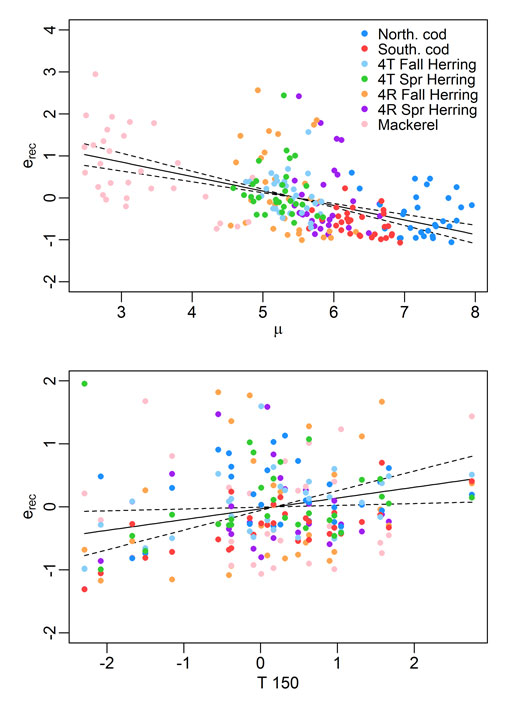Mechanisms affecting productivity and hence biomass of marine fish populations are still widely unknown. In a recent paper (Brosset et al. 2019), we assessed the contribution of recruitment to population growth and identify the main drivers of elasticity of population growth to recruitment variability in the Gulf of St Lawrence ecosystem. For this, we analysed the population dynamics of 7 stocks (4 herring, 2 cod and 1 mackerel stock) in the Gulf of St Lawrence. While these stocks share the same environment, they represent different trophic levels (top predators, forage fish) and habitats (demersal, pelagic) as well as different historical exploitation.
The fish population is affected by the variation of many factors that are production of young (recruitment), fishing mortality, natural mortality (predation), and age at maturation… These effects are conveniently integrated by the properties of the population's transition matrix (e.g., Leslie matrix) and affect the population growth. Similar to what we did earlier (see post) we estimate the importance of recruitment on population growth and determine how this is affected by key parameters such as age structure, longevity, fishing mortality, environmental conditions and natural mortality (potential predators).
Using age-structured population matrices and Generalized Additive Model analysis, we found that population growth was most sensitive to recruitment variability with decreasing fish generation time, increasing water temperature and, in some cases, with predation. The dependence of population growth on recruitment, however, was generally close to 0, albeit higher for pelagic stocks than for demersal ones. This indicates that adult survival was more important than recruitment in shaping population growth and thus population size.
Why does it matter?
In previous studies (Durant & Hjermann 2017, Durant et al 2013), we have looked at the effects of fisheries on population growth rate and the sensitivity of population growth to climate as well as the role of changed population structure in mediating these effects. We found that there was a general tendency of an increase of the population growth with the increase of the contribution of recruitment (see post). The results of the recent paper (Brosset et al 2019) are in line with the ones from the previous studies and indicate that population growth may become increasingly dependent on recruitment variability with warming waters. The recent results also highlight that adult survival is the key factor to restore the considered fish stocks. However, the importance of recruitment to population growth makes these stocks more difficult to manage and call for flexible management strategies to cope with recruitment oscillations.
References:
Brosset, P., Durant, J.M., Van Beveren, E., Plourde, S. (2019) Fish population growth in the Gulf of St Lawrence: effects of climate, fishing and predator abundance. Marine Ecology Progress Series, 624,167-181 DOI: 10.3354/meps13029
Durant, J.M. and Hjermann, D.Ø. (2017). Age-structure, harvesting and climate effects on population growth of Arcto-boreal fish stocks. Marine Ecology Progress Series, 577, 177-188 DOI: 10.3354/meps12210
Durant, J.M., Hidalgo, M., Rouyer, T., Hjermann, D., Ciannelli, L., Eikeset, A., Yaragina, N., & Stenseth, N. (2013). Population growth across heterogeneous environments: effects of harvesting and age structure. Marine Ecology Progress Series, 480, 277-287 DOI: 10.3354/meps10308

Log in to comment
Not UiO or Feide account?
Create a WebID account to comment